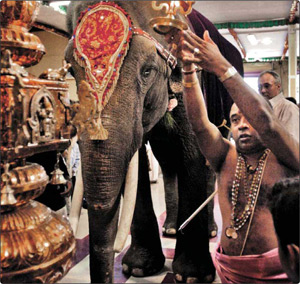 How Do We Visit the Temple?
How Do We Visit the Temple?
நாம் கோயிலுக்கு எப்படிச் செல்ல வேண்டும்?
Bagaimanakah Kita Ke Kuil?
Comment se passe la visite du temple?§

This is the temple to Lord Murugan in Tiruchendur, South India. It is on the seashore. Devotees come from all over to worship Lord Murugan here. It is one of the most popular temples in the country. தென் இந்தியாவிலுள்ள திருச்செந்தூரிலிருக்கும் முருகப் பெருமான் கோயில். இது கடற்கரையில் அமைந்திருக்கிறது. பக்தர்கள் முருகனை வழிபட பல இடங்களிலிருந்து வருகின்றனர். அந்நாட்டிலுள்ள பிரசத்திப் பெற்ற கோயில்களில் இதுவும் ஒன்று. Ini adalah kuil Tuhan Murugan di Tiruchendur, India Selatan. Ia terletak di persisiran pantai. Para penganut datang ke sini dari seluruh tempat untuk memuja Tuhan Murugan. Ia adalah salah satu kuil yang termasyhur di negara ini. Voici le temple du seigneur Murugan à Tiruchendur, en Inde du Sud, en bord de mer. Les fidèles viennent de partout pour y adorer Murugan. C'est un des temples les plus populaires du pays.§

In the temple, the priest is the loving servant of the God. He is a respected man trained in the arts of mantra and puja. When he performs the rites of worship, he is purifying himself and calling upon God to come and give you blessings. At special pujas and on festival days, the blessings are especially strong. We go to the temple to be close to God. We always feel His presence. We know that He and His devas can see us. We prepare ahead of time, just as we would when visiting the prime minister of a nation. Before our visit, we bathe and put on clean clothes. We bring an offering, such as fruits and milk and incense, or a lovely garland of flowers. Before entering, we take off our shoes and wash our feet. We walk clockwise around the temple or sanctum three times. Inside, we pay respects at the shrines. Prayers can be mentally expressed to God, and thanks given for all the good things in your life. The temple is the best place to let God hear what’s in your heart. If it is puja time, we sit quietly. The priest invites the Deity and honors Him with choice offerings, as one would welcome a king. When the puja is over, we sit quietly. We let the blessings wash over us like the soothing rays of the sun. §

கோயில் அர்ச்சகர் இறைவனின் அன்பான ஊழியர். அவர் மதிப்புமிகு மனிதர், பூசை செய்வதிலும் மந்திரங்கள் ஓதுவதிலும் அவர் பயிற்சி பெற்றவர். அவர் பூசைச் சடங்குகள் செய்யும் போது தன்னைச் தூய்மைப்படுத்திக் கொள்வதோடு இறைவனை அழைத்து உங்களுக்கு ஆசீர்வாதம் செய்யச் செய்கிறார். விசேஷ பூசையின் போதும் விழாக் காலங்களிலும் இறைவனின் ஆசீர்வாதம் வலுவானதாக இருக்கும். இறைவனோடு நெருங்கி இருப்பதற்காகக் கோயிலுக்குச் செல்கிறோம். அவரும் அவரது தரிசனத்தை நாம் எப்போதும் உணருகிறோம். அவரது தேவர்களும் நம்மைப் பார்க்கிறார்கள் என்று நமக்குத் தெரியும். ஒரு நாட்டுப் பிரதமரைச் சந்திக்கச் செல்வது போன்று நேரத்தை ஒழுங்குபடுத்திக் கொள்கிறோம். நமது இறைவனைச் சந்திப்பதற்கு முன் குளித்துப் புத்தாடை அணிகிறோம். ஏதாவது அன்பளிப்பு பால், பழங்கள், ஊதுபத்தி, அழகிய மாலை, மற்றும் மலர்கள் கொண்டு செல்கிறோம். கோயிலின் உள்ளே நுழைவதற்கு முன் நமது காலணியைக் கழற்றி விட்டு கை கால்களைக் கழுவுகிறோம். பிறகு கோயிலை அல்லது பிரகாரத்தை மூன்று முறை வலம் (சுற்றி) வருகிறோம். கோயிலின் உள்ளே சென்றதும் சுவாமிக்கு மரியாதை செலுத்துகிறோம். இறைவனிடம் நமது வழிபாட்டை அல்லது பிரார்த்தனையை மனத்துக்குள்ளே வெளிப்படுத்துகிறோம். மேலும் வாழ்க்கையில் நாம் அடைந்த நன்மைகளுக்காக நன்றி பாராட்டுகிறோம். உங்கள் மனத்தில் இருப்பத்தை இறைவன் கேட்பதற்குக் சிறந்த இடம் கோயிலாகும். பூசை நேரமாயிருந்தால் மௌனமாக உட்கார்ந்திருக்க வேண்டும். ஓர் அரசனை வரவேற்பது போன்று அர்ச்சகர் சுவாமிக்கு நைவேத்தியம் காட்டி மதிப்பும் மரியாதையும் கொடுத்து வரவேற்கிறார். பூசை முடிந்தவுடன் அமைதியாக அமர வேண்டும். சூரிய கிரணங்கள் நம்மைக் குளிப்பாட்டுவது போன்று கோயிலில் பாயும் அருட் கிரணங்கள் நம்மீது பாயும். §

Di kuil, sami adalah pelayan Tuhan yang dikasihi. Dia adalah orang yang dihormati dan terlatih dalam seni mantera dan puja. Apabila dia melakukan upacara sembahyang, dia sedang sucikan dirinya dan memanggil Tuhan untuk datang memberi rahmatNya kepada anda. Semasa puja khas dan hari perayaan, rahmatNya adalah lebih kuat. Kita pergi ke kuil untuk berada dekat dengan Tuhan. Kita sentiasa merasakan kehadiranNya. Kita tahu bahawa Dia dan dewa-dewiNya boleh melihat kita. Kita akan bersiap sedia terlebih dahulu, sepertimana apabila kita melawat perdana menteri sesebuah negara. Sebelum lawatan, kita mandi dan memakai pakaian bersih. Kita membawa pemberian seperti buah-buahan dan susu dan setanggi, atau sekalung bunga yang cantik. Sebelum masuk, kita menanggalkan kasut kita dan membasuh kaki. Kita berjalan ikut arah jam mengelilingi kuil atau bilik suci utama sebanyak tiga kali. Di dalam kuil, kita memberi hormat pada Tuhan. Doa boleh disampaikan kepada Tuhan secara mental dan kesyukuran diberikan untuk semua perkara baik dalam hidup anda. Kuil adalah tempat terbaik untuk memperdengarkan Tuhan apa yang terdapat dalam hati anda. Jika ianya waktu puja, kita duduk diam. Sami menjemput Tuhan dan menghormatiNya dengan pemberian terpilih, sepertimana seseorang menjemput seorang raja. Apabila puja tamat, kita duduk diam. Kita biar rahmatNya menyinari kita umpama sinaran matahari yang melegakan.§

Au temple, le prêtre est le serviteur dévoué de Dieu. C’est un homme respecté, formé à l’art des mantra et des puja. En accomplissant les rituels d’adoration, en invoquant pour nous la présence et les bénédictions de Dieu, il se purifie lui-même. Les bénédictions sont particulièrement intenses lors des puja spéciales, et des jours de fête. Nous allons au temple pour nous approcher de Dieu. Nous ressentons toujours Sa présence. Nous savons que Lui et ses dévas nous voient. Nous nous préparons à l’avance, comme si nous allions rendre visite au premier ministre d’un pays. Avant cette visite, nous prenons un bain et enfilons des vêtements propres. Nous apportons une offrande, des fruits, du lait, de l’encens ou une jolie guirlande de fleurs. Avant d’entrer, nous nous déchaussons et nous nous lavons les pieds. Nous faisons le tour du temple ou du sanctum trois fois, dans le sens des aiguilles d’une montre. A l’intérieur, nous présentons nos respects aux demeures des Dieux. Les prières peuvent être dites mentalement à Dieu, ainsi que les remerciements pour toutes les bonnes choses que la vie nous donne. Le temple est le meilleur endroit pour confier à Dieu ce que tu as dans le cœur. Si c’est l’heure de la puja, reste tranquillement assis. Le prêtre invite la Divinité et L’honore avec des offrandes bien choisies, dignes d’un roi. Lorsque la puja est terninée, on reste tranquillement assis. Les bénédictions se déversent sur nous comme les rayons apaisants du soleil.§
 The priest passes out sacraments after the worship. He gives holy ash, kumkuma, sandalwood paste, sacred water, flowers and food. அர்ச்சகர் பூசைக்குப் பின்னர் கற்பூர ஆரத்தியைப் பக்தர்களுக்குக் காட்டுகிறார். அவர் விபூதி, தீர்த்தம், சந்தனம், குங்குமம், பூ மற்றும் உணவுப் பிரசாதம் வழங்குகிறார். Sami sedang memberikan arati kepada para penganut selepas puja. Dia memberikan abu suci, kunkuma, chandana, air suci, bunga dan makanan. Le prêtre fait passer les sacrements après le rituel: cendre sacrée, kumkum, pâte de santal, eau bénie, fleurs et nourriture.§
The priest passes out sacraments after the worship. He gives holy ash, kumkuma, sandalwood paste, sacred water, flowers and food. அர்ச்சகர் பூசைக்குப் பின்னர் கற்பூர ஆரத்தியைப் பக்தர்களுக்குக் காட்டுகிறார். அவர் விபூதி, தீர்த்தம், சந்தனம், குங்குமம், பூ மற்றும் உணவுப் பிரசாதம் வழங்குகிறார். Sami sedang memberikan arati kepada para penganut selepas puja. Dia memberikan abu suci, kunkuma, chandana, air suci, bunga dan makanan. Le prêtre fait passer les sacrements après le rituel: cendre sacrée, kumkum, pâte de santal, eau bénie, fleurs et nourriture.§
 Many temples in India have an elephant to bless devotees. This temple in Toronto, Canada, hires a trained elephant for festivals. இந்தியாவிலுள்ள பல கோயில்களில் உள்ள யானைகள் பக்தர்களை ஆசீர்வதிக்கும். கனடா, தொரண்டோவிலுள்ள கோயில் நிர்வாகத்தினர் திருவிழாவுக்காக பழக்கப்பட்ட ஒரு யானையை வாடகைக்கு அமர்த்தியுள்ளனர். Kebanyakan kuil di India mempunyai gajah untuk merestu para penganut. Ini adalah sebuah kuil di Toronto, Kanada yang menyewa seekor gajah yang terlatih untuk perayaan. De nombreux temples en Inde ont un éléphant qui bénit les dévots. Pour les fêtes, ce temple de Toronto au Canada loue un éléphant dressé.§
Many temples in India have an elephant to bless devotees. This temple in Toronto, Canada, hires a trained elephant for festivals. இந்தியாவிலுள்ள பல கோயில்களில் உள்ள யானைகள் பக்தர்களை ஆசீர்வதிக்கும். கனடா, தொரண்டோவிலுள்ள கோயில் நிர்வாகத்தினர் திருவிழாவுக்காக பழக்கப்பட்ட ஒரு யானையை வாடகைக்கு அமர்த்தியுள்ளனர். Kebanyakan kuil di India mempunyai gajah untuk merestu para penganut. Ini adalah sebuah kuil di Toronto, Kanada yang menyewa seekor gajah yang terlatih untuk perayaan. De nombreux temples en Inde ont un éléphant qui bénit les dévots. Pour les fêtes, ce temple de Toronto au Canada loue un éléphant dressé.§